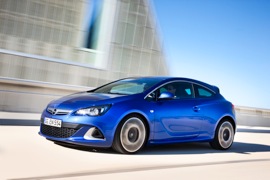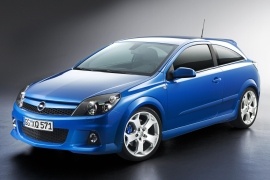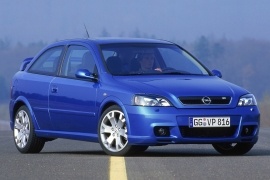OPEL Astra OPC Models/Series Timeline, Specifications & Photos
First production year: 2000
Engines: Gasoline
Body style: Hatchback
Based on the Astra GTC, the OPC version was the sportiest model in its range and, when it was launched, it was one of the most powerful hot-hatches.
The compact hot-hatch market evolved from power to look factor. When Vauxhall/Opel understood that, it made the GTC model, a sportier version of the Astra. But it did some more! While it had some predecessors with sporty engines, it installed it only on the GTC version, which was more of a coupe rather than a regular hatchback.
On the outside, the OPC took the same bodywork from the GTC version but improved it with a more aggressive body kit. A larger front spoiler, more profiled side sills and a roof-spoiler in the back completed the image of a “bad-boy-racer”. A twin exhaust in the back with chromed tips was offered to amplify the sporty image. Moreover, an option for aerodynamic package added a second spoiler over the roof-spoiler.
Inside, there was the regular Astra dashboard with some OPC badges on the gear-stick lever and the flat-bottom steering wheel. They also redesigned the dials, which were lit in red when the OPC mode was engaged. But the most attention was attracted by the sport-bucket seats with holes in the integrated headrest, like those for race harnesses.
For the drivetrain, the OPC retained the same struts in the front and DeWatt linkage in the rear, but with adaptive dampers. Power came from a 280 hp engine and went to the front wheels via a 6-speed manual and, most important, through a mechanical limited-slip differential.
Opel introduced its contender in the hot-hatch segment with a highly tuned Astra GTC in 2005 and brought more than just a set of wheels and a body kit.
The German carmaker was highly respected in the hot-hatch segment during the mid-'80s, thanks to the Kadett GSI. Still, over time it lost its edge in front of Volkswagen Golf GTI, Ford Focus ST, or the Renault Megane Renault Sport, to name just a few. So in 2005, GM decided to return with a highly tuned version for the Astra GTC, adding the Opel Performance Center (OPC) badge to the nameplate.
Unlike its main competitors, which were more or less just the three-door versions of the five-door hatchbacks, the Astra GTC featured a different bodywork than its siblings. At the front, it sported a wide mesh grille flanked on the sides by scoops with fog lights. From its sides, the 18" light-alloy wheels made a clear difference compared to the rest of the range. The carmaker installed a center-mounted exhaust at the back, under the bumper, and a roof spoiler on top of the tailgate to complete the sporty image.
The sports treatment continued inside with OPC's blue accents on the dashboard, the door cards, and the Recaro front sports seats. In addition, the same three letters were added on the steering wheel and inside the tachometer. To further enhance the car's sporty look, Opel added a set of aluminum pedals.
But the most important part of the car was the drivetrain. It was the most powerful turbocharged two-liters in its class. Moreover, Opel offered an adaptive suspension, which stiffened the dampers and made the car handle even better on a race track. Finally, a close-ratio six-speed manual sent the power to the front wheels.
Opel introduced the second generation of the Astra in Europe in 1998 and waited another two years before offering it as a true hot hatch, in 2000, in two bodywork versions: a three-door hatchback and a five-door station wagon.
The most potent three-door Astra had received a redesigned front fascia. While it retained the same headlights as its siblings, it sported a new wrapped-around front bumper with a wider lower air dam and two fog lights in squared clusters. Furthermore, a pair of aerodynamically profiled door mirrors adorned the car's sides. In addition, on the sides, the unique design of the light-alloy wheels confirmed the vehicle's sporty character. At the same time, on the back, the automaker installed a wing on the deck.
Inside, the carmaker installed an enhanced instrument cluster with white dials. The changed interior went further, with an OPC badge on the center console and sport bucket seats and side bolstering good enough to provide decent support during high-speed cornering. Apart from the front seats, the automaker also placed a split-folding bench in the back that expanded the trunk space.
Under the hood, OPC (Opel Performance Center) installed a turbocharged 2.0-liter engine, which provided 200 hp. The carmaker paired it with a five-speed manual, providing decent performance for its segment.


